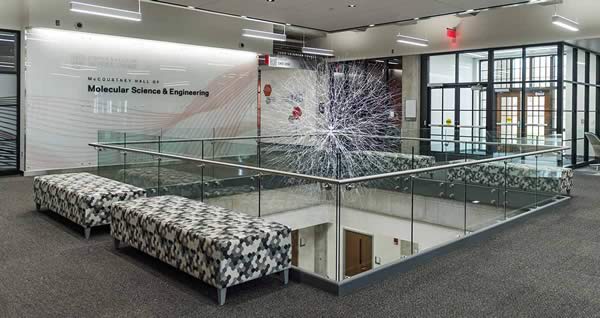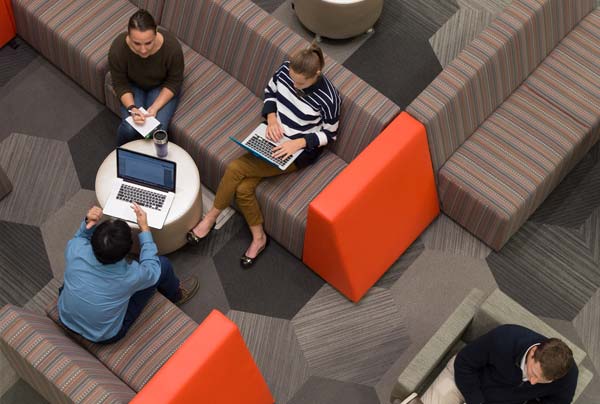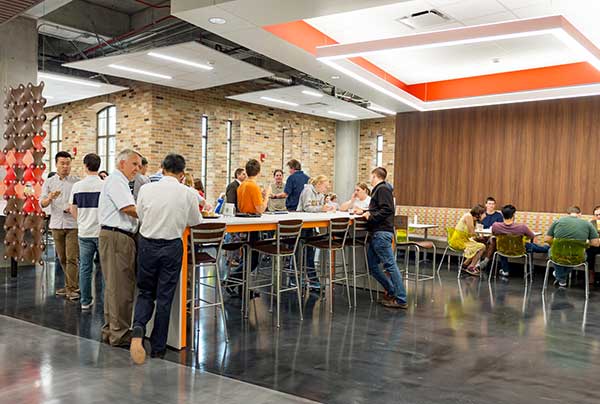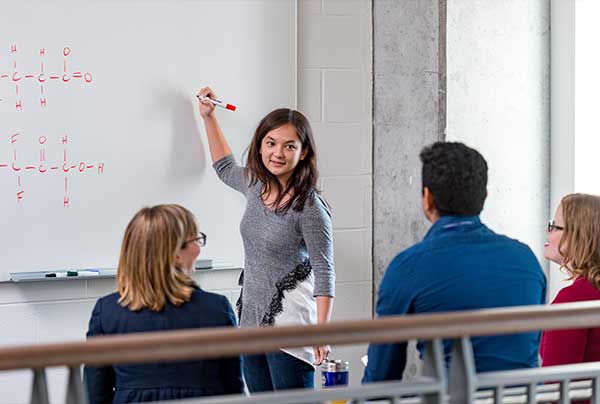Change sometimes happens slowly, then all at once. On the northeast side of Notre Dame’s campus, a new quadrangle has emerged on space that seemingly just days ago was occupied by a parking lot and sidewalks. Anchoring this new quad on its east side is the state-of-the-art, 220,000 square foot McCourtney Hall of Molecular Science and Engineering. Its opening comes as shifts in the broader research community are hastening a change in how scientific discoveries are taking place.
“You can’t do anything these days without working with someone else, and usually in a very different discipline,” said Brian Baker, the Rev. John A. Zahm Professor of Structural Biology and chair of the Department of Chemistry & Biochemistry within the College of Science. Faculty from Baker’s department are among those who began working at McCourtney Hall when the building opened for the fall semester 2016.
You can’t do anything these days without working with someone else, and usually in a very different discipline.Brian Baker
“Chemistry and biochemistry are fundamental disciplines,” Baker said. “Everything from medicinal chemistry to drug discovery to cancer biology, so much of it depends on fundamental chemistry and biochemistry.”
Facilitating interdisciplinary discoveries is not just a stated goal for the work being done at McCourtney Hall; it was a guiding principle of the very design of the building. Researchers from two Colleges – Engineering and Science – will join forces in McCourtney to tackle three key programmatic areas: analytical sciences and engineering, chemical and biomolecular engineering, and drug discovery. They’ll do so in spaces intended to foster interaction during which common challenges may surface, and innovative solutions may result. Notre Dame vice president for research Robert J. Bernhard said that even includes informal interaction among researchers.
“When we talked to people who worked in places like this, we heard anecdotes about people having lunch together, discussing each other’s challenges,” Bernhard said. “All of the sudden, they do a little collaborative background work, write a proposal, and they have a research project,” Bernhard said.




McCourtney Hall features design choices throughout to enhance collaboration. Office spaces employ an interactive layout, with easy access to enhance approachability. The labs are designed intentionally to be filled by more than one faculty member. Many of the walls are glass, creating lines of sight in and through the labs. Large social spaces - mostly absent in other facilities - make McCourtney as sociable an environment as one could imagine. Even the terminology used to describe the occupants sounds closer to a community than a science lab.
“We’re co-locating faculty with common interests into what we’re calling ‘neighborhoods,’” said Ed Maginn, the Dorini Family Professor of Energy Studies and chair of the Department of Chemical and Biomolecular Engineering within the College of Engineering. As one example of co-locating complementary research interests, Maginn cites a group of faculty working on polymers, with a mix of researchers working near each other on either the production or application sides of the field.
To conduct the research, McCourtney is acting as a home for both new and existing equipment. Sometimes that status requires unorthodox moves; a nuclear magnetic resonance (NMR) spectroscope, a piece of equipment that is rarely if ever moved from its initial installation spot, was moved from Stepan Chemistry Hall over the summer to its new home in McCourtney. The state-of-the-art equipment and infrastructure contained in the building conveys a strong sentiment regarding Notre Dame’s investment in research.
“This will allow us to recruit in particular science and engineering fields, as it gives us a modern research facility and the space to perform the work in these fields,” Bernhard said. Approximately 40 percent of the space in the building is intentionally being held in anticipation of new research hires. “In addition to researchers, I think there are a lot of undergraduates and alumni who can’t visualize a building like McCourtney Hall until they visit, and see into the labs and see the collaboration that is taking place here.”
Work that may start with an exchange of ideas, and accelerate into a breakthrough.
“I’m really anticipating some magic to happen here,” Bernhard said. “I think within a couple years, we’re going to hear some stories where something really significant comes out of interdisciplinary interaction.”